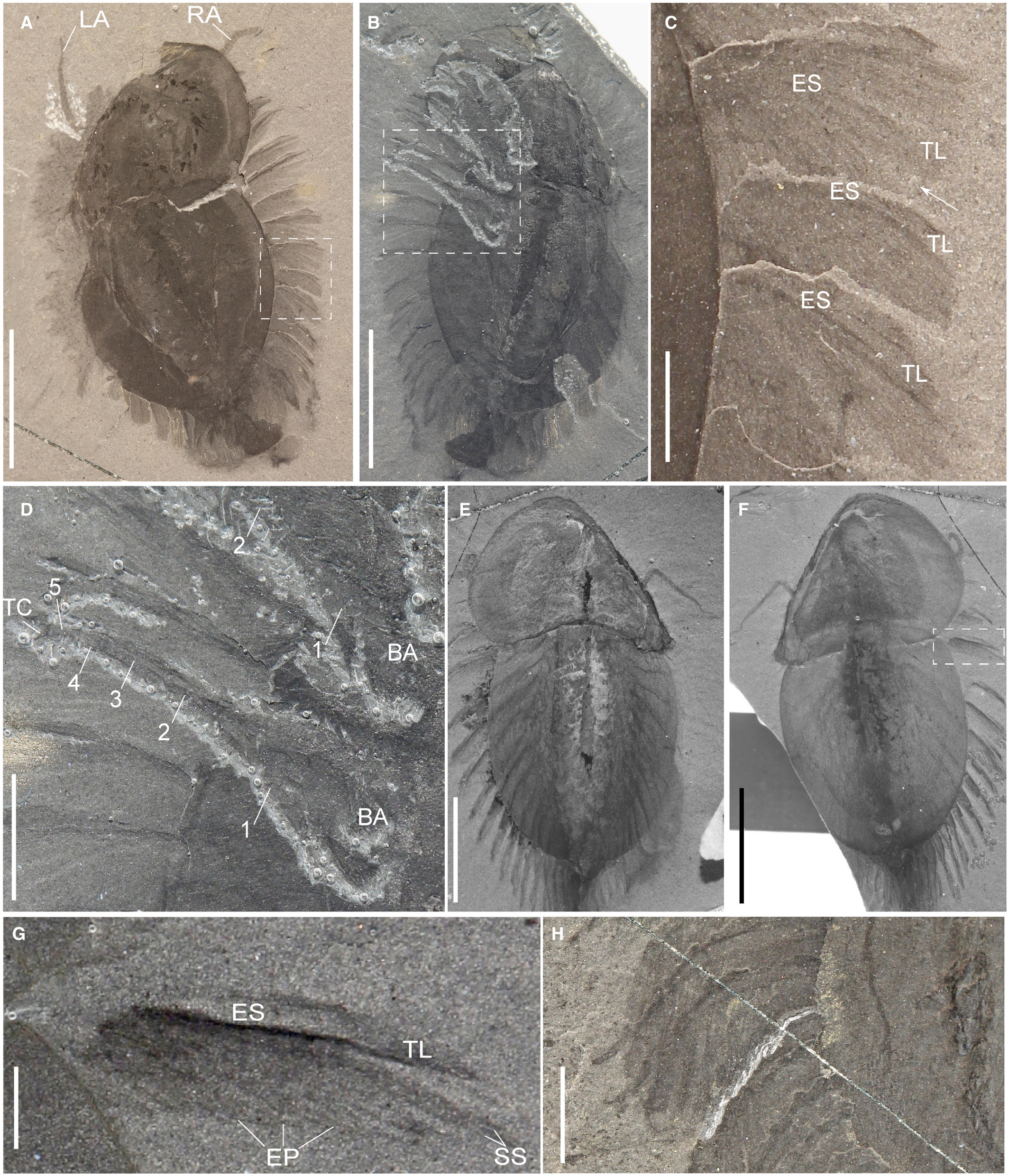|
Pseudonaraoia
''Pseudonaraoia'' is a genus of small (about long) marine arthropods within the family Naraoiidae, that lived during the late Middle Ordovician period (or Darriwillian epoch). The only species presently known is ''Pseudonaraoia hammanni'' (the genus is monotypic). Etymology The genus name indicates the likeness to the related genus Naraoia. The species was named in honor of Dr. Wolfgang Hammann (†2002), the outstanding German palaeontologist who studied both trilobites and naraoids. Description ''P. hammanni'' is almost flat (dorso-ventrally). The upper (or dorsal) side of the body consists of a non-calcified headshield ( cephalon) and tailshield (pygidium) of about equal length, without any body segments in between. The body is strongly narrowed at the articulation between cephalon and pygidium. Both shields have a narrow border, reminiscent of some effaced agnostid trilobites Trilobites (; meaning "three lobes") are extinct marine arthropods that form the class Tril ... [...More Info...] [...Related Items...] OR: [Wikipedia] [Google] [Baidu] |
Nektaspida
Nektaspida (also called Naraoiida, Nektaspia and Nectaspida) is an extinct order of non- mineralised artiopodan arthropods. They are known from the mid-Cambrian to the upper Silurian. Originally classified as trilobites, which they superficially resemble, they are now placed as close relatives as members of the Trilobitomorpha within Artiopoda. The order is divided into three major families; Emucarididae, Liwiidae, and Naraoiidae. Naming history and taxonomic placement The order was originally proposed by Raymond in 1920 as Nektaspia. Størmer corrected it to Nectaspida for the 1959 ''Treatise on Invertebrate Paleontology'' to conform with the names of the other trilobite orders. Whittington described it in 1985 with the spelling Nektaspida; the revised 1997 Treatise by Raymond and Fortey uses this spelling, as do other modern works. Whittington (1985) placed the order in the Trilobita. Cotton & Braddy (2000) place it in a new "Trilobite clade" containing the Trilobita, recogni ... [...More Info...] [...Related Items...] OR: [Wikipedia] [Google] [Baidu] |
Naraoiidae
Naraoiidae is a family, of extinct, soft-shelled trilobite-like arthropods, that belongs to the order Nectaspida. Species included in the Naraoiidae are known from the second half of the Lower Cambrian to the end of the Upper Silurian. The total number of collection sites is limited and distributed over a vast period of time: Maotianshan Shale and Balang Formation (China), Burgess Shale and Bertie Formation (Canada), the Šárka Formation (Czech Republic), Emu Bay Shale (Australia), Idaho and Utah (USA). This is probably due to the rare occurrence of the right circumstances for soft tissue preservation, needed for these non-calcified exoskeletons. Ecology Naraoiids probably were deposit feeders (''Naraoia'' and ''Pseudonaraoia''), predators or scavengers (''Misszhouia''), living on the sea floor. Description The species of the family ''Naraoiidae'' are almost flat (dorso-ventrally). The upper (or dorsal) side of the body consists of a non-calcified transversely oval or se ... [...More Info...] [...Related Items...] OR: [Wikipedia] [Google] [Baidu] |
Animal
Animals are multicellular, eukaryotic organisms in the Kingdom (biology), biological kingdom Animalia. With few exceptions, animals Heterotroph, consume organic material, Cellular respiration#Aerobic respiration, breathe oxygen, are Motility, able to move, can Sexual reproduction, reproduce sexually, and go through an ontogenetic stage in which their body consists of a hollow sphere of Cell (biology), cells, the blastula, during Embryogenesis, embryonic development. Over 1.5 million Extant taxon, living animal species have been Species description, described—of which around 1 million are Insecta, insects—but it has been estimated there are over 7 million animal species in total. Animals range in length from to . They have Ecology, complex interactions with each other and their environments, forming intricate food webs. The scientific study of animals is known as zoology. Most living animal species are in Bilateria, a clade whose members have a Symmetry in biology#Bilate ... [...More Info...] [...Related Items...] OR: [Wikipedia] [Google] [Baidu] |
Trilobite
Trilobites (; meaning "three lobes") are extinct marine arthropods that form the class Trilobita. Trilobites form one of the earliest-known groups of arthropods. The first appearance of trilobites in the fossil record defines the base of the Atdabanian stage of the Early Cambrian period () and they flourished throughout the lower Paleozoic before slipping into a long decline, when, during the Devonian, all trilobite orders except the Proetida died out. The last extant trilobites finally disappeared in the mass extinction at the end of the Permian about 252 million years ago. Trilobites were among the most successful of all early animals, existing in oceans for almost 270 million years, with over 22,000 species having been described. By the time trilobites first appeared in the fossil record, they were already highly diversified and geographically dispersed. Because trilobites had wide diversity and an easily fossilized exoskeleton, they left an extensive fossil record. The stu ... [...More Info...] [...Related Items...] OR: [Wikipedia] [Google] [Baidu] |
Portable Document Format
Portable Document Format (PDF), standardized as ISO 32000, is a file format developed by Adobe in 1992 to present documents, including text formatting and images, in a manner independent of application software, hardware, and operating systems.Adobe Systems IncorporatedPDF Reference, Sixth edition, version 1.23 (53 MB) Nov 2006, p. 33. Archiv/ref> Based on the PostScript language, each PDF file encapsulates a complete description of a fixed-layout flat document, including the text, fonts, vector graphics, raster images and other information needed to display it. PDF has its roots in "The Camelot Project" initiated by Adobe co-founder John Warnock in 1991. PDF was standardized as ISO 32000 in 2008. The last edition as ISO 32000-2:2020 was published in December 2020. PDF files may contain a variety of content besides flat text and graphics including logical structuring elements, interactive elements such as annotations and form-fields, layers, rich media (including video con ... [...More Info...] [...Related Items...] OR: [Wikipedia] [Google] [Baidu] |
Palaeontology (journal)
''Palaeontology'' is one of the two scientific journals of the Palaeontological Association (the other being '' Papers in Palaeontology''). It was established in 1957 and is published on behalf of the Association by Wiley-Blackwell. The editor-in-chief is Barry Lomax (University of Nottingham). ''Palaeontology'' publishes articles on a range of palaeontological topics, including taphonomy, functional morphology, systematics, palaeo-environmental reconstruction and biostratigraphy. According to the ''Journal Citation Reports'', the journal has a 2017 impact factor The impact factor (IF) or journal impact factor (JIF) of an academic journal is a scientometric index calculated by Clarivate that reflects the yearly mean number of citations of articles published in the last two years in a given journal, as i ... of 3.730, ranking it 1st out of 55 journals in the category "Paleontology". References External links * Paleontology journals Publications established in 1957 ... [...More Info...] [...Related Items...] OR: [Wikipedia] [Google] [Baidu] |
Trilobita
Trilobites (; meaning "three lobes") are extinction, extinct marine arthropods that form the class (biology), class Trilobita. Trilobites form one of the earliest-known groups of arthropods. The first appearance of trilobites in the fossil record defines the base of the Atdabanian Stage (geology), stage of the Early Cambrian Period (geology), period () and they flourished throughout the lower Paleozoic before slipping into a long decline, when, during the Devonian, all trilobite orders except the Proetida died out. The last extant trilobites finally disappeared in Permian–Triassic extinction event, the mass extinction at the end of the Permian about 252 million years ago. Trilobites were among the most successful of all early animals, existing in oceans for almost 270 million years, with over 22,000 species having been described. By the time trilobites first appeared in the fossil record, they were already highly diversified and geographically dispersed. Because trilobites had ... [...More Info...] [...Related Items...] OR: [Wikipedia] [Google] [Baidu] |
Agnostida
Agnostida is an order of arthropod which have classically been seen as a group of highly modified trilobites, though some recent research has doubted this placement. Regardless, they appear to be close relatives as part of the Artiopoda. They are present in the Lower Cambrian fossil record along with trilobites from the Redlichiida, Corynexochida, and Ptychopariida orders, and were highly diverse throughout the Cambrian. Agnostidan diversity severely declined during the Cambrian-Ordovician transition, and the last agnostidans went extinct in the Late Ordovician. Systematics The Agnostida are divided into two suborders — Agnostina and Eodiscina — which are then subdivided into a number of families. As a group, agnostids are isopygous, meaning their pygidium is similar in size and shape to their cephalon. Most agnostid species were eyeless. The systematic position of the order Agnostida within the class Trilobita remains uncertain, and there has been continuing deb ... [...More Info...] [...Related Items...] OR: [Wikipedia] [Google] [Baidu] |
Naraoia
''Naraoia'' is a genus of small to average size (about 2-4½ cm long) marine arthropods within the family Naraoiidae, that lived from the early Cambrian to the late Silurian period. The species are characterized by a large alimentary system and sideways oriented antennas. Etymology The name is derived from Narao, the name of a group of small lakes in Cataract Brook canyon, above Hector on the Canadian Pacific Railway, British Columbia, Canada.Walcott, C.D. Middle Cambrian Branchiopoda, Malacostraca, Trilobita, and Merostomata. In: Cambrian Geology and Paleontology II. Smithsonian. 1914. s:Cambrian Geology and Paleontology/Volume 2/Middle Cambrian Branchiopoda, Malacostraca, Trilobita, and Merostomata History of the classification When the fossil was first discovered in Canada's Burgess Shale, it was believed to be a crustacean, such was the difference between this and other trilobites. Its continuous shield hid most of its structure, interfering with proper classification. Wh ... [...More Info...] [...Related Items...] OR: [Wikipedia] [Google] [Baidu] |
Cephalon (arthropod Head)
The cephalon is the head section of an arthropod. It is a tagma, i.e., a specialized grouping of arthropod segments. The word cephalon derives from the Greek κεφαλή (kephalē), meaning "head". Insects In insects, ''head'' is a preferred term. The insect head consists of five segments, including three (the labial, maxillary and mandibular) necessary for food uptake, which are altogether known as the gnathocephalon and house the suboesophageal ganglion of the brain, as well as the antennal segment, and an ocular segment, as well as a non segmented fused section of the head where the archicerebrum is housed known as the acron. See also arthropod head problem. Chelicerates and crustaceans In chelicerates and crustaceans, the cephalothorax is derived from the fusion of the cephalon and the thorax, and is usually covered by a single unsegmented carapace. In relation with the arthropod head problem, phylogeny studies show that members of the Malacostraca class of cru ... [...More Info...] [...Related Items...] OR: [Wikipedia] [Google] [Baidu] |
Arthropod
Arthropods (, (gen. ποδός)) are invertebrate animals with an exoskeleton, a Segmentation (biology), segmented body, and paired jointed appendages. Arthropods form the phylum Arthropoda. They are distinguished by their jointed limbs and Arthropod cuticle, cuticle made of chitin, often Mineralization (biology), mineralised with calcium carbonate. The arthropod body plan consists of segments, each with a pair of appendages. Arthropods are bilaterally symmetrical and their body possesses an exoskeleton, external skeleton. In order to keep growing, they must go through stages of moulting, a process by which they shed their exoskeleton to reveal a new one. Some species have wings. They are an extremely diverse group, with up to 10 million species. The haemocoel, an arthropod's internal cavity, through which its haemolymph – analogue of blood – circulates, accommodates its interior Organ (anatomy), organs; it has an open circulatory system. Like their exteriors, the internal or ... [...More Info...] [...Related Items...] OR: [Wikipedia] [Google] [Baidu] |



.jpg)


